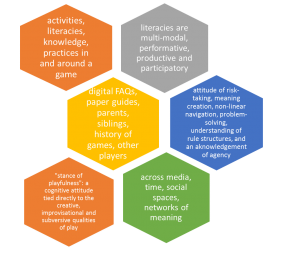Prensky (2001, pp. 05-01) argues that computer and videogames are potentially the most engaging experiences, because they comprise of following elements:
1. Games are a form of fun. That gives us enjoyment and pleasure.2. Games are form of play. That gives us intense and passionate involvement.3. Games have rules. That gives us structure.4. Games have goals. That gives us motivation.5. Games are interactive. That gives us doing.6. Games are adaptive. That gives us flow.7. Games have outcomes and feedback. That gives us learning.8. Games have win states. That gives us ego gratification.9. Games have conflict/competition/challenge/opposition. That gives us adrenaline.10. Games have problem solving. That sparks our creativity.11. Games have interaction. That gives us social groups.12.Games have representation and story. That gives us emotion.
According to Klopfer et al (2009, pp. 4.) in order to understand how learning environments can effectively incorporate play we need to define it. While playing people, children and adults alike, are excercising freedom along five distinct axes:
1. freedom to fail
2. freedom to experiment
3. freedom to fashion identities
4. freedom of efford, and,
5. freedom of interpretation
People are experiencing all of the freedoms of unstructured play, although games have defined goals and rules (Gee 2003, cited in Klopfer et al, 2009). Players submit to rules and structures only if they can continue to be playful.
Gaming
Gaming is the act arising from the combination of play with games and comprises of many elements. The graphic below attempts to present some of the elements involved in gaming as described by Klopfer et al (2009, pp.5).
Learning:
Learning is necessary to distinguish the purpose of games for education rather than for advertising (advergaming), health (games for health), or social change (social impact games). Learning also captures the cognitive change process that results from the interaction of learner, content, and strategies. (Richard Van Eck, in Print)
The promise of games is that we can harness the spirit of play to enable players to build new cognitive structures and ideas of substance (Klopfer et al, 2009, pp.5)
Game based learning (GBL) is a type of game play that has defined learning outcomes. Generally, game based learning is designed to balance subject matter with gameplay and the ability of the player to retain and apply said subject matter to the real world.
Game based learning describes an approach to teaching, where students explore relevant aspect of games in a learning context designed by teachers. Teachers and students collaborate in order to add depth and perspective to the experience of playing the game.
Simulation is the imitation of the operation of a real-world process or system over time. The act of simulating something first requires that a model be developed; this model represents the key characteristics or behaviors/functions of the selected physical or abstract system or process.
Gamification takes game elements (such as points, badges, leaderboards, competition, achievements) and applies them to a non-game setting. It has the potential to turn routine, mundane tasks into refreshing, motivating experiences.
The focus of the Serious Games movement is most commonly associated with what may best be described as “Games for Training”. That is, Serious Games were initially conceived as being designed to train people for tasks in particular jobs. This might be training army personnel to better identify enemy combatants, or training insurance salesmen how to close a deal. These tasks may be physical or cognitive, or a combination of both. But they are characterized by their specificity and applicability for particular work-related purposes. While Serious Games may appeal to people simply interested in playing fun games, they are typically targeted at a captive audience
„Educational entertainment (also referred to by the portmanteau neologism[1] edutainment[2]) is content designed to educate and to entertain. It includes content that is primarily educational but has incidental entertainment value, and content that is mostly entertaining but contains educational value.“

